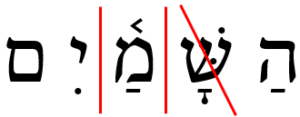And now, back to the basics!
The following is a handout that I presented to my students in our last Hebrew 1 session (if you would like to purchase access to the recorded [unlisted] videos, contact me here). Reading Biblical Hebrew is a necessary component for efficient learning, and in order to do that, you need to know how to divide words into syllables, just like we did when we were learning English. Here are the principles used for syllabification/syllable division.
Notes on Syllabification – For Reading!
It is important that as we are learning to read Hebrew, we think in terms of phonetics and syllables, just like in English. Remember that the Hebrew orthography (writing) should NOT be seen as symbols to be decoded; rather, the combination of consonant and corresponding vowel should be sounded out.
-
- Syllables in Hebrew follow this pattern: Hebrew is read from right to left, first pronouncing the consonant followed by the subsequent vowel, located either underneath the letter (generally) or on top of it (in the case of cholam).
- A syllable is said to be either OPEN (ending in a vowel [Cv – consonant-vowel]) or CLOSED (ending in a consonant [CvC – consonant-vowel-consonant]).
The letters ה, ו, and י, while they are also consonants, also function as VOWEL LETTERS, meaning that they often simply just mark a long vowel and do not function as a consonant. The same is true of א when it has no vowel (“quiescent aleph”).
אִשָּׁה “woman” – isha
פָּנָיו “his face” – panav (not panayv)
מְלַאכְתְּךָ “your work” – melachtecha
In Hebrew, each consonant MUST have one corresponding vowel, unless it is closing a syllable. If there is no vowel that goes with a consonant, the letter is a consonant rather than a vowel letter.
A Cv pattern is called an “open” syllable; a CvC (a syllable closed by a consonant) is called a CLOSED syllable.
So, when we divide a word into syllables, we first look for a consonant, and then its corresponding vowel. We can then mark our syllable divisions.
בָּרָא
בָּ ׀ רָא
Cv Cv
Therefore, the word בָּרָא (“he created”) is two syllables. The aleph is quiescent (without a vowel), so it doesn’t close the syllable.
Three-syllable words
דְּבָרִים devarim “words, matters, things”: Cv | Cv | CvC
דְּבָרִים
דְּ | בָ | רִים
CvC Cv Cv
Remember begad-kefat (mnemonic for ב ג ד כ פ ת). These six letters take a dagesh lene (דָּגֵשׁ קַל) at the beginning of a word AND at the beginning of a new syllable following silent sheva. See דְּבָרִים.
Example – מִדְבָּר [divided as מִדְ | בָּר]
EXAMPLE: Gen. 1:1 divided into syllables.
בְּרֵאשִׁית בָּרָא אֱלֹהִים אֵת הַשָּׁמַ֫ים וְאֵת הָאָ֫רֶץ׃
בְּ | רֵא | שִׁית בָּ | רָא אֱ | לֹ | הִים אֵת הַשְׁ | שָׁ | מַ֫ | יִם וְ | אֵת הָ | אָ֫ | רֶץ׃
 Note on הַשָּׁמַ֫יִם: We would divide the shin in this word with a DIAGONAL line (see the image) to show that it is to be considered as part of two different syllables: hash | sha | má | yim. We do not pronounce two shins when reading, and when writing out the division, it is best to simply write the letter twice – the first time with silent sheva (הַשְׁ | שָׁ | מַ֫ | יִם).
Note on הַשָּׁמַ֫יִם: We would divide the shin in this word with a DIAGONAL line (see the image) to show that it is to be considered as part of two different syllables: hash | sha | má | yim. We do not pronounce two shins when reading, and when writing out the division, it is best to simply write the letter twice – the first time with silent sheva (הַשְׁ | שָׁ | מַ֫ | יִם).